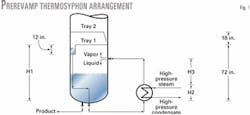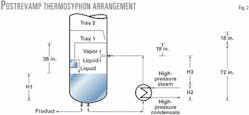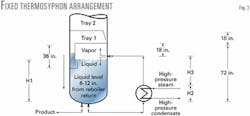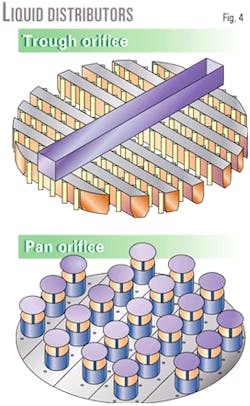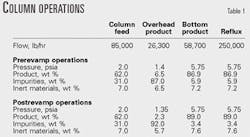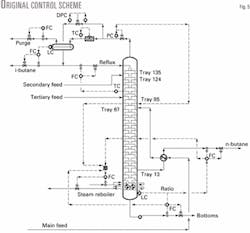Successful troubleshooting combines a thorough understanding of the process and equipment, application of chemical engineering basics to problem solving, and good field techniques and data interpretation skills. Troubleshooting often fails due to faulty, incomplete, and misleading numbers.
This article reviews three case histories that demonstrate successful troubleshooting:
- Operational instability in a petrochemical tower due to a faulty reboiler conversion.
- Off-specification petrochemical tower operations due to fouling and an out-of-level distributor.
- Control instability on a stab-in reboiler on a petrochemical plant deisobutanizer due to improper design.
Malfunctioning reboiler loop
A petrochemical plant operator revamped a high-pressure (>100 psig) column with new trays. The column used a once-through thermosyphon reboiler for column boil-up. The prerevamp column arrangement had a feed pipe inside the column that came from a sump through the boot and then out the tower bottom to the reboiler feed line (Fig. 1).
Postrevamp
After the revamp, the operator commissioned the column and stabilized operations. The column, however, did not meet project objectives due to insufficient boil-up. We identified the problem by analyzing field data and comparing simulation work done before the column was revamped.
When reviewing the column revamp design and inspection records, we found that the internal pipe feeding the reboiler and tray sump had been removed. The liquid-level driving force through the reboiler was substantially reduced, which created flow instability problems in the reboiler loop (Fig. 2).
The thermosyphon converted from a once-through to a recirculating operation when vessel internals were removed. The tower lost approximately one theoretical stage during the revamp. The tower had sufficient stages to operate, however; the loss of one stage was not significant, therefore.
Thermosyphon reboilers
A once-through thermosyphon reboiler is classified as a natural-circulation reboiler. Natural circulation draws liquid from the bottom tray and circulates it directly to the reboiler. The stream that returns to the column is partially vaporized and net return liquid is recovered as bottom product (Fig. 1).1
A reboiler can have different heating zones:
- Liquid sensibly heating to its bubble point.
- Liquid vaporization.
- Vapor superheating.
At low liquid rates, liquid feed entering the reboiler is essentially vaporized. The liquid heating zone is small, and nucleate boiling occurs almost immediately.
Mist flow develops and gas superheating occurs above the nucleate boiling zone in the reboiler. The nucleate boiling heat-transfer coefficient is high; but the gas-superheating coefficient is low. The net effect is that high vaporization reduces the effective reboiler heat-transfer coefficient.
The temperature difference in the liquid heating and nucleate boiling zones is high and relatively constant because the low two-phase static head, and hydraulic losses in the tubes and outlet piping, does not significantly raise the boiling point.
In the mist-flow zone, gas heating due to a severe temperature pinch at the outlet for low liquid levels can lead to a significant temperature rise. This temperature rise results in a low overall integrated temperature difference. The temperature rise, combined with the low overall heat-transfer coefficient, explains poor reboiler performance at low liquid rates.2
An increased liquid driving head leads to more liquid flow. The hydrostatic pressure difference between H1 and H2 + H3 (Fig. 2) must increase for this to happen. As liquid driving head increases, circulation rate rises, which lengthens the nucleate boiling zone and reduces the mist-flow zone. This improves reboiler performance.
Problem fixes
The operator could have repaired the column by redesigning the bottom tray and reinstalling the internal downpipe to feed the reboiler. This would result in extensive downtime due to the amount of welding required to complete the repair.
Another option was to raise the liquid level of the column to within 6-12 in. of the reboiler return nozzle (Fig. 3). Seal pan modifications were also required to prevent tray flooding. The effective control range for the bottoms liquid rate was narrow but still possible. This option required little downtime with minimal required hot work.
The operator decided on the latter option.
We checked downcomer backup at maximum operating rates, which would be 8 in. plus 3 in. of downcomer submergence. This was acceptable because it would not interfere with column operations.
The operator restarted the column after making the required modifications. The operator modified the seal pan and increased the operating liquid level to within 6-12 in. of the reboiler return nozzle (Fig. 3).
Column product was within specifications and there were no operational problems.
Ineffective liquid distribution
A Westlake Chemical Corp. petrochemical column was achieving poor separation efficiency while at normal operating rates. We collected operating data to evaluate column performance, which showed that column separation efficiency had significantly deteriorated through the plant's run cycle. There was no indication of operational problems-excessive pressure drop, highly subcooled reflux, or poor reboiler performance.
Poor liquid distribution
A natural suspect for performance failure in any packed column is poor distributor performance.3 Liquid distribution in packed bed columns is one of the most important aspects of packed tower design.
Packed towers are more sensitive to liquid and vapor maldistribution than trayed towers. Poor vapor and liquid distribution to a packed bed can result in lower efficiency.4
Many types of liquid distributors are in commercial use. The most commonly used in fractionation services are the trough-orifice and pan-orifice distributors (Fig. 4). Both can suffer severe maldistribution problems and both require proper design, fabrication, and installation.
With large-scale maldistribution, packing efficiency decreases with longer packed beds. This is due to composition nonuniformity generated by pinching and the development of wall flow. With small packings, this condition may occur without initial liquid maldistribution.5
When a packed bed fouls, it will have poor natural distribution and lower efficiency.
Tower troubleshooting
Westlake collected column data and developed a column simulation based on field data and heat and material balances. The model showed that the column had lost approximately seven theoretical stages.
A gamma scan was the next troubleshooting step. The scan revealed severe liquid maldistribution above the feed. Other packed beds appeared to have fair liquid distribution. After carefully analyzing the gamma scan and simulation results, Westlake decided that:
- The bed above the feed distributor was fouled, which contributed to lower column efficiency.
- The two-phase feed distributor contributed to maldistribution above the feed.
- Liquid distribution to the remaining beds was fair but could improve.
Table 1 shows operational data collected before the column was shut down and repaired. The column never operated to its full potential. After carefully analyzing all the field data and simulation results, we developed a three-part plan to fix the column:
- Replace damaged packing. The first step was to replace the fouled bed packing.
- Fix damaged distributors. The second step was to replace the feed liquid distributor and to clean and inspect the remaining liquid distributors. We chose the feed liquid distributor because it was the most liquid loaded. Simulation results showed that the distributor was beyond hydraulic capacity at maximum operating rates.
We reviewed the liquid distributor design and found several problems. The design called for a drip point density of 6 drip points/sq ft. This is a minimum number of drip points for good efficiency. The drip point density was low to maximize distributor orifice size, which would minimize the risk of plugging since the system had a history of fouling.
Drip-point layout vs. fouling reduction is a tradeoff that often requires engineering judgment rather than definite calculations or standard engineering practice manuals. The packed beds in this tower were tall (>30 ft) and more drip points would help performance. Preferred practice is approximately 10 drip points/sq ft.
The drip-point pattern showed marginal liquid distribution at the packed bed's periphery. Poor periphery flow is common for distributors in which concerns about wall flow cause designers to underirrigate the tower's periphery.1 A new distributor with a drip point density of 9 drip points/sq ft would improve periphery flow.
The remaining distributors were hydraulically acceptable at maximum operating rates and would just be cleaned and releveled.
- Upgrade feed distribution. The final part of the plan was for Westlake to replace the existing two-phase feed pipe with a new design. A troubleshooting analysis showed that the existing pipe caused liquid entrainment into the packed bed above the feed distributor. Entrainment from the feed pipe aggravated liquid maldistribution in the packed bed.
Fixing the tower
Westlake shut down the tower for repairs and to inspect the existing distributors, which had several problems. Many of the trough orifices were plugged, mainly at the distributor's outer area. This type of plugging occurred in every distributor in the tower.
In addition, every distributor was not level. Normally when a distributor is not level, column efficiency falls dramatically. There are many causes for an out-of-level distributor:
- Installation problems.
- Lack of leveling features in the distributor design.
- Inherent tilt in the distributor fabrication.
- Tray support rings out of level.
The plugging problem degraded tower performance and the out-of-level installation prevented the tower from meeting its full potential. Many towers fail to meet their operating targets for these reasons.
Certain distributor features can reduce fouling effects.6 Standard designs do not usually include these features. Inappropriate application of standard equipment and practices is a major source of operating problems and lost profits.
Westlake installed the new distributor, cleaned and leveled the remaining distributors, and replaced the packing in the second bed. Table 1 shows column performance after the revamp. Overhead product purity improved significantly.
After the column revamp, bottom product purity was 89-91%. Overall column pressure drop was the same level as before the revamp. The revamp met its objectives.
Deisobutanizer control problems
A petrochemical plant deisobutanizer was suffering from control problems.
The deisobutanizer had three feeds, a vapor distillate purge, liquid distillate product, vapor sidedraw product, and a bottoms liquid purge. The vapor sidedraw product was heat integrated against the unit feed.
Fig. 5 shows the unit configuration and overall control scheme. The original control scheme used:
- Overhead pressure on direct pressure control.
- Air-fin motor speed for overhead temperature control.
- Hot-vapor bypass for tower-to-distillate drum differential pressure control.
- Reflux on temperature control in the tower's top section.
- Distillate product on distillate drum level control.
- Bottoms and sidedraw vapor product on bottoms level control.
- Maximum reboiler duty as required by overhead pressure control, sidedraw vapor product rate, or bottoms product rate.
Fig. 5 does not show feedforward and feedback connections to other parts of the unit. This complex control scheme never worked properly.
After considerable experimentation, we found that the major contributing factor for control failure was the bottoms level. Removing the bottoms level control loops dramatically stabilized unit operations.
The control scheme derived from operator experimentation had the bottoms and sidedraw (n-butane) products on manual flow control. Typically, the operators kept the bottoms rate much higher than necessary to allow for more stable operations in the rest of the plant.
One problem with this operation, however, was difficulty in getting accurate bottoms level readings. The bottoms level was essentially uncontrollable. Wide swings in bottom level upset tower operations and Tray 13 n-butane vapor draw composition.
The operator implemented two changes to improve bottoms level control:
- First, a level control algorithm based on reboiler duty, reboiler size, column geometry, and estimated froth density predicted the bottoms level.7 The calculated value varied from 0% level to several hundred percent with stable operation. Operations would destabilize at unpredictable calculated level values.
- Second, the operator added a differential pressure (DP) cell across the tower to predict bottoms level based on pressure drop from the lower level tap to the tower's top. The DP cell measured liquid height in the boot plus the pressure drop across 135 trays.
The two changes combined for a small improvement in tower operations. The operator postponed further work until a planned shutdown.
Before the shutdown, we conducted a more thorough review of the problem. Fig. 6 shows the tower bottom configuration using a chimney tray to hold liquid on the stab-in reboilers. Fig. 6 also shows the actual liquid level and the minimum liquid level required to make the reboilers work.
Liquid held on the chimney tray by its outlet weir only wetted two rows of tubes in the reboiler bundles. With little liquid on the reboilers, the tower could not add much heat. At start-up, the operators quickly discovered that the tower worked when they deliberately ran the tower level above 100%. Obviously, the minimum liquid level was above the upper tap of the level control range.
We checked several solutions to implement during the turnaround:
- Raise the chimney tray outlet weir to hold a liquid level on the exchangers.
- Modify the level control instrumentation to replace the DP cell.
Due to a low bottoms rate-less than 1% liquid traffic to the reboiler-the operator selected the second choice. At high liquid rates, and with turbulence in the boiling pool around the reboiler, liquid overflowing the weir could be more or less than the bottoms rate requires to purge heavies from the unit.
The tower continued to operate flooded above the reboiler bundle levels. During a shutdown, the operator removed several trays, installed new level bridle taps, and added new DP cells. The unit now operates on full advanced control.
Advanced control can work well, but only if the base unit equipment and pro cess can meet the operating objectives.
References
- Kern, D.Q., Process heat transfer, McGraw-Hill Inc., New York, 1950.
- McKetta, J.J., Heat transfer design methods, Marcel Dekker Inc., New York, 1992.
- Sloley, A.W., Golden, S.W., and Martin, G.R., "Why towers do not work," presented to the AIChE Spring National Meeting, Houston, Mar. 19-23, 1995.
- Zygula, T.M., and Dautenhahn, P.C., "Use of process simulation for distillation design," presented to the AIChE Annual Meeting, Atlanta, Mar. 5-9, 2000.
- Kister, H.Z., Distillation design, McGraw-Hill Inc., New York, 1992.
- Sloley, A.W., and Martin, G.R., "Subdue solids in towers," Chemical Engineering Progress, January 1995, pp. 64-73.
- Hepp, P.S., "Internal column reboilers - liquid level measurement," Chemical Engineering Progress, February 1963, pp. 66-70.
The authors
Timothy M. Zygula is a senior process engineer with the Westlake Group, Lake Charles, La. Previously he was a process engineer with Glitsch, Inc. Zygula holds a BS in chemical engineering from the University of South Florida and an MS in chemical engineering from McNeese State University.
Karl Kolmetz is the process engineering manager at Titan Petrochemical Sdn. Bhd., Johor Bahru, Malaysia, a division of the Westlake Group. He has worked for the Westlake Group for the past 6 years. He also served as an engineer and operations supervisor at Charter-Phibro Refining Inc., Houston, for 17 years. Kolmetz holds a degree in chemical engineering from the University of Houston. He is a member of AIChE.
Andrew W. Sloley is the director of The Distillation Group Inc., College Station, Tex. He has also served as a principal with a consulting firm, a project manager and process engineer with Glitsch Inc., and a process engineer with Exxon Chemical Technology. Sloley holds a BS in chemical engineering from the University of Tulsa. He is a member of the AIChE, an associate member of ASME and ACS, a graduate member of IChemE (UK), and a licensed professional engineer in Texas.
